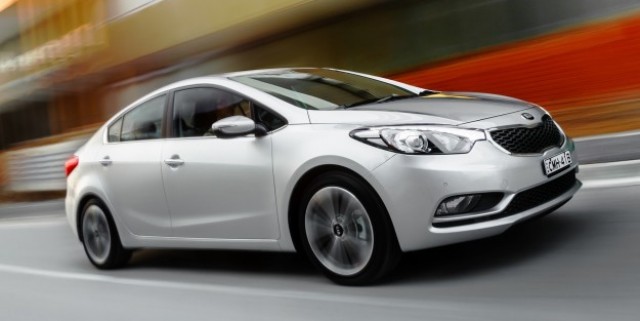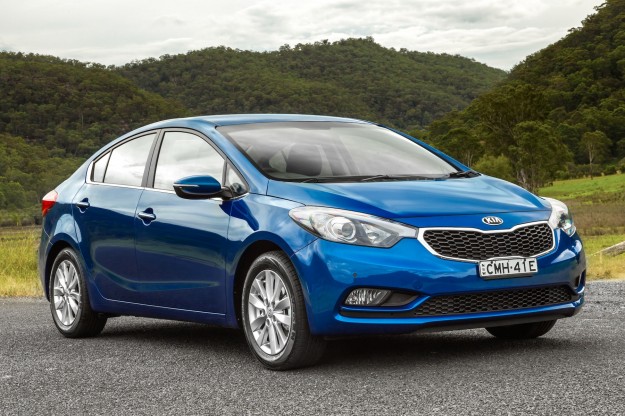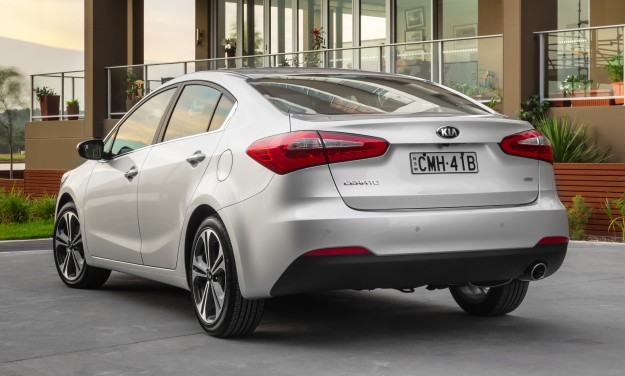Our Rating:
Performance, Ride & Handling 4 Comfort & Interior 3.5 Quality & Design 3.5 Value & Features 4

The 2013 Kia Cerato represents the third instalment of a nameplate that carries the South Korean brand's fortunes in Australia's crucial small car segment.
Kia Australia continues to forgo the company's European-focused Cee'd model for the Cerato that is sold almost everywhere else from the US (where it's know as the Forte) to its domestic market.
For a brand that has been synonymous with budget pricing, there's a bit of a shock with the all-new Kia Cerato sedan.

The base model actually starts $600 higher than before – from $19,990. That's still one of the lowest RRPs in the class, however, matching the starting points of both the Nissan Pulsar and Toyota Corolla.
That buys a bigger car, too, with the Kia Cerato sedan (the hatch comes mid 2013) now spanning more than 4.5 metres from nose to tail, along with an extra bit of width (5mm) but a reduction in height (by 25mm) as part of a more aerodynamic and visually dynamic exterior design.
And while you won't find a kitchen sink in the new Cerato, Kia has otherwise thrown a fair bit of kit at the three trim levels that carry over: S, Si and SLi.

The Kia Cerato S, which is aimed primarily at fleet buyers, includes Bluetooth connectivity, a trip computer, 16-inch steel wheels (an inch larger than old model), cruise control, foglights, USB/iPod compatibility, and front and rear parking sensors.
The Si, from $23,990, adds 16-inch wheels with alloy rims, chrome exterior trim, electrically folding side mirrors, rear air vents, push button engine start, 4.3-inch touch screen, and reverse view camera.
At the top of the range, the Kia Cerato SLi costs from $27,990 and includes 17-inch alloys, leather trim, heated front seats and electrically adjustable driver's seat, LED daytime running lights, sunroof, and dual-zone climate control.?While the optional six-speed automatic adds $2000 to each specification level, only the SLi gets paddleshift transmission levers. All Ceratos come with Kia's five-year warranty program.
Only the Si and SLi specification levels get the more powerful version of two new petrol engines, however.
The base S's 110kW/178Nm 1.8-litre four-cylinder still has a few more kilowatts than your average small car. A Toyota Corolla, for example, has only 103kW.
It performs adequately around town and on the freeway, though you'll especially notice the more satisfying extra grunt of the bigger petrol engine on hills or when overtaking.
The direct fuel injection, 2.0-litre version of the new 'Nu' engine (above) is certainly an improvement over the old 'Theta II' engine of the same capacity used in the old Cerato.
Besides the obvious output gains – up 14kW to 129kW and up 11Nm to 209Nm – the new 2.0-litre has a greater willingness to rev, and sounds more refined as it does so.
And although the 2.0-litre doesn't start to get properly interesting until about 3000rpm, it's tractable from low revs and doesn't require excessive downchanges if you opt for the standard manual gearbox.
The Kia Cerato Si or SLi manual will accelerate from 0-100km/h in a creditable 8.5 seconds, or 9.0 seconds with the auto. The 1.8 is noticeably slower at 9.3 and 10.2 seconds respectively.
The new manual is a great example of how Kia has improved the mechanical refinement of the Cerato.
Previously the manual shift was notchy, aggravated by a clutch pedal that was overly light and with a vague biting point.
This time, the relationship between gear shifter and clutch pedal is a far more harmonious arrangement – allowing for smoother starts and gearchanges.
The 2.0-litre engine isn't quite as lively when paired with the six-speed auto, though the important point for the majority of buyers who will choose the self-shifter is that the six-speeder is smarter at picking the right gear than the previous four-speeder.
According to official fuel figures, there's no gain or penalty with either gearbox: both achieve 7.4 litres of regular unleaded per 100km. There's half a litre difference with the 1.8L: a best of 6.6L/100km with the manual and 7.1L/100km with the auto.
Kia spent plenty of effort improving the noise refinement of the Cerato, while Kia Australia spent six months working on the steering and suspension tuning of the new Cerato. It was time and money invested wisely.
Some tyre roar will inevitably be heard on the coarsest of Australia's country roads, but generally the Cerato provides a highly civilised level of hush.
And whether traversing uneven suburban avenues, patchy freeways or bumpy country roads, the new Kia Cerato has a greater level of suspension compliance that creates a universally comfortable ride.
That applies to both the 16-inch (S and Si) and 17-inch rubber (SLi), with the latter adding an extra layer of firmness and grip.
Not coincidentally, body control is also vastly improved. Despite persisting with a torsion beam rear suspension rather than the more expensive but more sophisticated multi-link set-up employed by leading rivals such as the Ford Focus and Mazda 3, the Cerato delivers reassuring – if not quite rewarding – handling.
It offers both balance and grip, and decent steering.
The 'Flexsteer' system offers three modes, though unlike the similar set-up in the sister Hyundai i30 you have to be driving at lower speeds to pick the varying degrees of electric assistance.
The Sport mode doesn't feel as artificially heavy as it does in the i30, and although the Cerato's steering doesn't match the linearity of the likes of the Focus or Mazda 3 it has also been well calibrated to largely avoid the vague on-centre feeling common to many Korean vehicles.
Drivers can alter both the height and reach of the steering wheel, and the front seats are generally comfortable whether cloth (S and Si) or leather (SLi).
Ergonomically, the new interior of the Kia Cerato (S above, SLi below) is more driver focused than before, with the curving centre stack of heating/ventilation and infotainment controls angled towards the person steering the car.
The central digital display is only colour (and larger), however, in the range-topping SLi model.
Larger screens can be found in some rival models including the arguably more stylish-looking interiors of the i30 and Elantra from sister company Hyundai.
The perception of plastics quality is also patchier in the Cerato than the i30, and the base model gets fewer soft-touch sections than the Si and SLi grades. The S's steering wheel also doesn't feel quite as good in the hands.
The tactility of all the buttons and switches is excellent, though, regardless of variant, while there are plenty of good storage options – including a console bin and a jalousie-style compartment sandwiching the gearlever on the centre console.
Rear seat occupants get an angled bench that helps under-thigh support, and there's reasonable legroom though nowhere near as generous as that in the similarly sized Nissan Pulsar sedan.
The boot fits a full-size spare beneath its floor, includes release levers for the seatbacks, and is decent, if not special, in size at 421 litres.
That's an increase of just six litres over the previous model's boot, but it's bigger improvements in a number of key areas that make the latest Kia Cerato notably better than its predecessors.
Where the old Cerato was one of the company's least-convincing models, Kia's best-selling model is now also its finest.
Pick the strongest variant, the mid-spec $23,990 Kia Cerato Si, and you have a small car that launches itself into the mix with the Ford Focus, Hyundai i30, Holden Cruze, Volkswagen Golf and Mazda3 as the most recommended of the popular pack.
2013 Kia Cerato range
Kia Cerato S
Price: from $19,990
Engine: 1.8-litre four-cylinder
Power: 110kW at 6500rpm
Torque: 178Nm at 4700rpm
Transmission: 6-speed manual or 6-speed auto
0-100km/h: 10.2 seconds auto (9.3s manual)
Fuel consumption: 7.1L/100km auto (6.6L manual)
CO2 emissions: 158-159g/km
Weight: 1287-1304kg
Kia Cerato Si
Price:?from $23,990
Engine: 2.0-litre direct injection four-cylinder
Power: 129kW at 6500rpm
Torque: 209Nm at 4700rpm
Transmission: 6-speed manual or 6-speed auto
0-100km/h: 9.0 seconds auto (8.5s manual)
Fuel consumption: 7.4L/100km (auto and manual)
CO2 emissions: 176-177g/km
Weight: 1296-1319kg
Kia Cerato SLi
Price:?from $27,990
Engine: 2.0-litre direct injection four-cylinder
Power: 129kW at 6500rpm
Torque: 209Nm at 4700rpm
Transmission: 6-speed manual or 6-speed auto
0-100km/h: 9.0 seconds auto (8.5s manual)
Fuel consumption: 7.4L/100km (auto and manual)
CO2 emissions: 176-177g/km
Weight: 1296-1319kg





